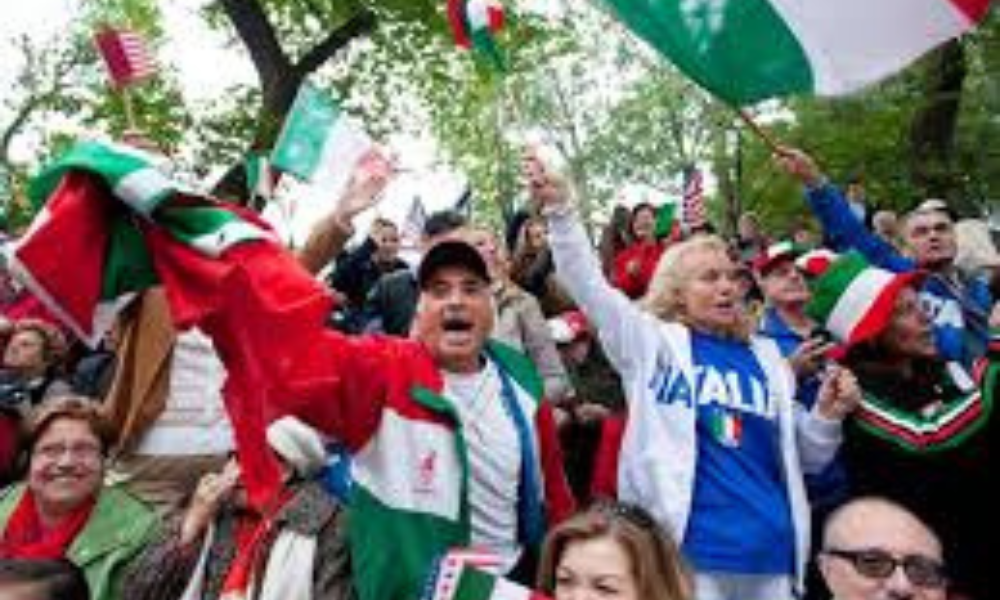Italiani nel Mondo
I nostri parenti e amici all’estero e cosa significano per l’Italia PARTE 2-Our relatives and friends overseas and what they mean to Italy PART 2

I nostri parenti e amici all’estero e cosa significano per l’Italia PARTE 2
Nella prima parte di questa trilogia di articoli su cosa significano per l’Italia i nostri parenti e amici all’estero, abbiamo fornito una breve sintesi della storia dell’emigrazione italiana nel mondo.
Infatti, quest’anno Brasile e Argentina hanno celebrato ufficialmente i 150 anni dell’emigrazione italiana nei loro paesi, anche se indubbiamente gli italiani erano presenti in entrambi ben prima del 1875.
Il primo passo per comprendere cosa queste comunità italiane nel mondo fanno per l’Italia e, soprattutto, potrebbero ancora fare in futuro, è quello di guardare finalmente oltre gli stereotipi dell’“italianità”, ovvero l’italianità dei discendenti di questi migranti nel corso di tanti, tanti decenni.
E questo significa capire che i discendenti degli immigrati italiani non sono “italiani”, ma un amalgama delle loro origini italiane e della loro crescita nel paese in cui sono nati.
Per fare questo, dobbiamo riconoscere che gli stereotipi e i meme sui social media NON rappresentano la nostra storia o la nostra identità, ma sono una visione superficiale del nostro passato perché i nipoti e i pronipoti degli antenati immigrati non hanno un’esperienza diretta di ciò che è accaduto, indipendentemente dal paese, tre, quattro, cinque o più generazioni fa, a partire dal fatto che il maggior numero di vittime della criminalità organizzata italiana, lo stereotipo più comune e vergognoso di noi italiani, erano proprio gli immigrati italiani…
Purtroppo, c’è poca documentazione su molti periodi del passato e i ricordi tramandati di generazione in generazione sono cambiati, non solo perché i figli dei migranti non capivano l’italiano o, nella maggior parte dei casi, il dialetto parlato dai genitori in casa, ma anche perché, troppo spesso, la nostra visione del passato è cambiata perché ogni generazione vede il passato con occhiali colorati di rosa, in un modo che non riflette ciò che è realmente accaduto.
Un esempio di questo tipo di visione “filtrata” del passato che non dobbiamo mai dimenticare è chiederci: quanto della discriminazione e dei problemi dei genitori migranti è stato nascosto ai figli, spesso per aiutarli a integrarsi nel nuovo paese?
Sì, i bambini hanno subito discriminazioni, come possiamo attestare per esperienza diretta, ma i genitori molto raramente, se non mai, hanno raccontato ai figli le proprie esperienze che, non di rado, erano anche più dure di quelle subite dai figli.
Quindi, questi ricordi limitati sono stati tramandati di generazione in generazione e sono cambiati, come inevitabilmente accade con questo tipo di ricordi.
Purtroppo, a causa di questo processo e della documentazione limitata, non potremo mai conoscere molti dettagli del passato, ma ciò non significa che non possiamo recuperare il più possibile di ciò che abbiamo.
E per farlo, le comunità italiane in tutto il mondo, comprese le innumerevoli pagine “italiane” sui social media, devono collaborare per documentare la nostra storia. Un esempio di come ciò possa essere fatto ci viene dagli Stati Uniti.
La foto qui sotto mostra il famoso Empire State Building di New York, che un tempo era l’edificio più alto del mondo e un simbolo inconfondibile non solo della città, ma anche degli Stati Uniti.

All’inizio del mese l’edificio ha sventolato con orgoglio i colori della bandiera italiana perché ottobre è il “Mese del patrimonio italiano” negli Stati Uniti, quando i discendenti dei milioni di italiani emigrati in quel Paese possono esprimere l’orgoglio per le loro origini.
Questo modello è da applaudire e con questo articolo suggeriamo che questa iniziativa venga estesa alle comunità italiane di tutto il mondo per incoraggiare i discendenti non solo ad essere orgogliosi di queste origini, ma soprattutto a lavorare insieme per garantire che la storia di queste esperienze sia scritta non solo paese per paese, ma anche città per città e comunità per comunità.
Esistono già organizzazioni in ogni paese con l’obiettivo di raccogliere e registrare questa storia, ma finora non è stato sufficiente per comprendere le esperienze di ogni paese, che sono le vere ragioni per cui ogni comunità italiana è diversa dalle altre, pur condividendo alcuni aspetti comuni.
E questo deve essere fatto in modo metodico, seguendo le migliori pratiche di ricerca e registrazione della storia, lasciando che sia la documentazione a parlare e non basandosi su semplici ricordi.
E questa ricerca deve sempre tenere presente che giudicare quanto sia “italiano” qualcuno o qualcosa non può basarsi sull’idea di tradizioni italiane “standard” perché, in realtà, queste cambiano da famiglia a famiglia, da città a città e da regione a regione e, naturalmente, cambiano nel tempo nel nuovo paese di residenza e ora sono spesso molto diverse dalle versioni originali…
Inoltre, una storia di questo tipo deve includere anche una categoria di migrazione apparsa solo negli ultimi decenni, i visti Working Holiday, che consentono ai giovani cittadini stranieri di lavorare in un paese per un periodo prima di decidere se rimanervi in modo permanente.
Questo tipo di migrazione è possibile solo grazie ai voli internazionali veloci e relativamente economici che ora consentono a molti giovani di “assaporare” la vita in più di un paese, cosa impossibile fino a poco tempo fa in termini storici…
Naturalmente, una ricerca storica di questo tipo ha un costo, ma è un costo che le comunità dovrebbero condividere perché solo comprendendo appieno il nostro passato possiamo capire chi siamo veramente e, purtroppo, la tendenza internazionale a pensare all’“essere italiani” solo in termini di cucina, stereotipi e meme, fa sì che troppi discendenti di migranti italiani non conoscano, e tanto meno comprendano, la vera profondità e grandezza del loro patrimonio culturale.
Istituire un “Mese del patrimonio italiano” internazionale, e ottobre sarebbe l’ideale per un progetto del genere, dovrebbe essere una priorità per tutti noi, anche perché aiuterebbe gli italiani in Italia a capire non solo perché i nostri parenti e amici in tutto il mondo sono diversi, ma soprattutto il vero costo in termini umani della decisione di iniziare una nuova vita in un altro paese, sia in Europa che in un altro continente.
E nel documentare questa storia, gli italiani in ogni paese, a cominciare dall’Italia stessa, arriveranno finalmente a comprendere il ruolo svolto dai migranti nello sviluppo dell’Italia, a partire dalle rimesse, come abbiamo recentemente spiegato, e che questi contributi possono continuare a lungo nel futuro promuovendo ogni aspetto dell’Italia, dalla nostra cultura ai prodotti di ogni tipo.
E nella terza parte di questa trilogia spiegheremo come ciò sia possibile.
Our relatives and friends overseas and what they mean to Italy PART 2
In the first part of this trilogy of articles about what our relatives and friends overseas mean to Italy, we gave a brief summary of the history of Italian migration around the world.
In fact, this year Brazil and Argentina officially celebrated 150 years of Italian migration into the countries, although there undoubtedly were Italians in both well before 1875.
The first stage for understanding what these Italian communities around the world do for Italy and, above all, could still do in the future, we must finally look beyond the stereotypes of “Italianità”, in other words, the Italianness of the descendants of these migrants over those many, many decades.
And this means understanding that descendants of Italian migrants are not “Italians”, but an amalgam of their Italian origins and growing up in their country of birth
In order to do this, we must recognize that the stereotypes and the memes on the social media do NOT represent our history or our identity, but are a superficial view of our past because the grandchildren and great grandchildren of the immigrant ancestors do not have direct experience of what happened, no matter in which country, three, four, five and more generations ago, starting with the fact that the greatest numbers of victims of Italian organized crime, the most common and shameful stereotypes of us Italians, were precisely Italian migrants…
Sadly, there is little documentation of many periods of the past, and the memories passed on over the generations have changed, not only due to the children of the migrants not understanding the Italian, or, in most cases, the dialect, spoken by the parents in the home, but also because, all too often, our views of the past have changed because each generation sees the past with rose coloured glasses in a way that does not reflect what actually happened.
One example of this sort of “filtered” view of the past that we must never forget is by asking ourselves, how much of the discrimination and the problems of the migrant parents were hidden from the children, often to help them integrate into the new country?
Yes, the children suffered discrimination themselves, as we can certify from direct experience, but the parents very rarely, if ever, told the children of their own experiences which, not infrequently, were even harsher than what the children suffered.
So, these limited memories have been passed on for generations, and they have changed as such memories inevitably do.
Unfortunately, as a result of this procedure, and the limited documentation, we will never know many details of the past, but that does not mean that we cannot recover as much as possible of what we do have.
And to do this, the Italian communities around the world, and this should also include the countless “Italian” pages on the social media, must work together to document our history and one example of how this can be done comes from the United States.
The photo below is of the famous Empire State Building in the New York that was once the world’s tallest building and an unmistakable symbol of not only the city, but of the United States as well.

At the start of the month the building proudly flew the colours of the Italian flag because October is “Italian Heritage Month” in the United States when the descendants of the millions of Italians who migrated to that country can express pride in their origins.
This model is to be applauded, and with this article we suggest that this initiative be expanded to Italian communities around the world to encourage the descendants to not just be proud of these origins, but, above all, to work together to ensure that the history of these experiences is written not only country by country, but also city by city and community by community.
There are already organizations in every country with the aim of collecting and recording this history, but up to now it has not been enough to be able to understand the experiences in each country which are the real reasons why each Italian community is different from every other, although they do share things in common.
And this must be done methodically, following the best practices of researching and recording history, and by letting the documentation speak, and not basing it on simple memories.
And this research must always keep in mind that judging how “Italian” someone or something is cannot be based on the idea of “standard” Italian traditions because, in reality, they change from family to family, from town to town and region to region, and, of course, they change over time in the new country of residence and now they are often very different from the original versions…
Furthermore, such a history must also include a category of migration that has only appeared in recent decades, Working Holiday Visas, which allow young foreign citizens to work in a country for a period before making the decision whether or nor to stay there permanently.
This type of migration is only possible due to the fast and relatively cheap international flights that now allow many young people to “taste” life in more than one country, something that was impossible until recently in historical terms…
There is, of course, a cost for such historical research, but it is one that the communities should share because we only know who we really are when we fully understand our past, and, unfortunately, the international tendency to think of “being Italian” only in terms of cooking, stereotypes and memes, means that too many descendants of Italian migrants do not know, let alone understand, the true depth and greatness of their Cultural Heritage.
Setting up an international “Italian Heritage Month”, and October would be ideal for such a project, should be a priority for all of us, also because it would help Italians in Italy to understand not just why our relatives and friends around the world are different, but especially, the real cost in human terms of the decision to start a new life in another country, whether in Europe or in another continent.
And in documenting this history, Italians in every country, starting in Italy itself, will finally come to understand the role played by the migrants in Italy’s development, starting with the remittances, as we recently explained, and that these contributions can continue for a long time into the future by promoting every aspect of Italy, from our Culture to products of every kind.
And in part 3 of this trilogy, we will explain how this is possible.


















